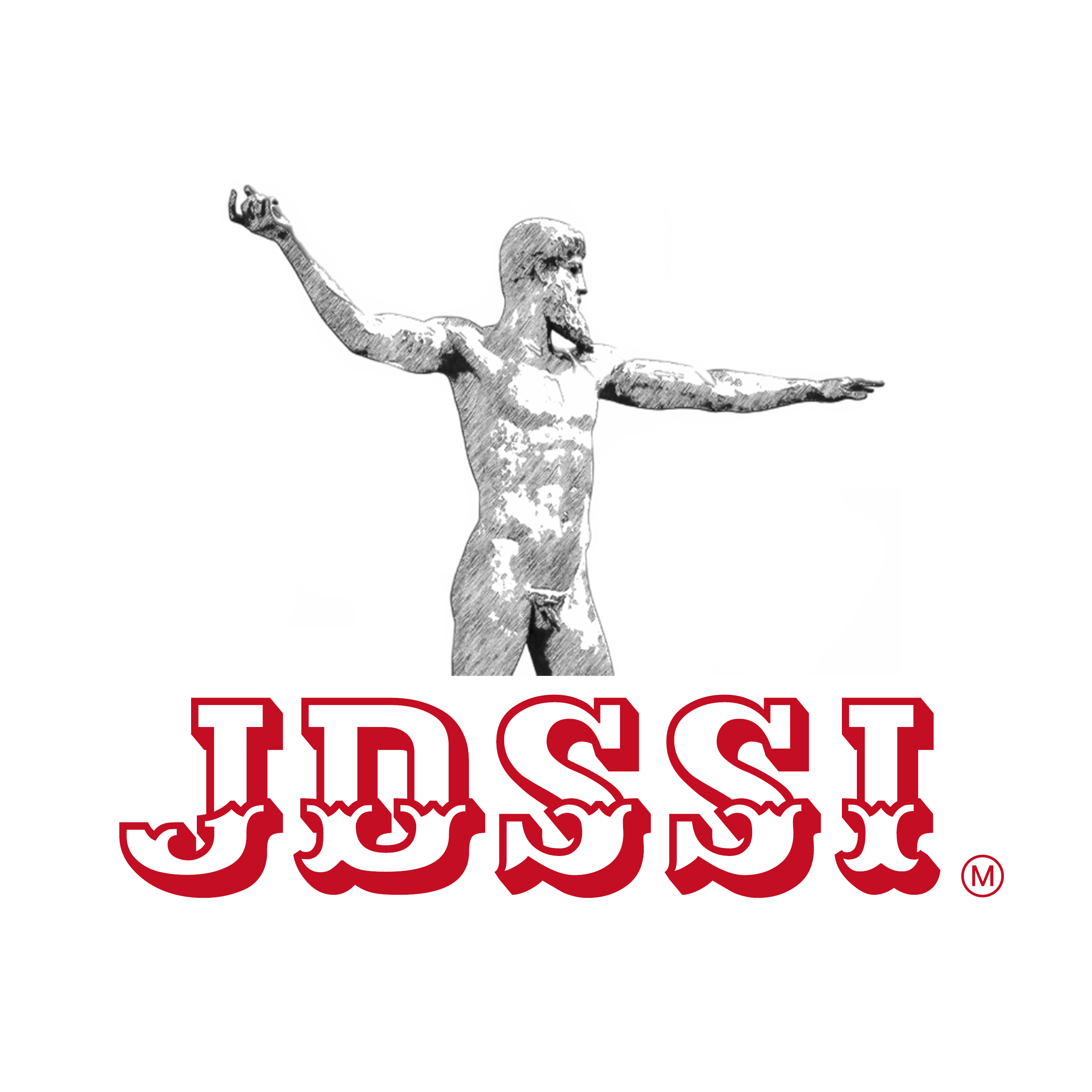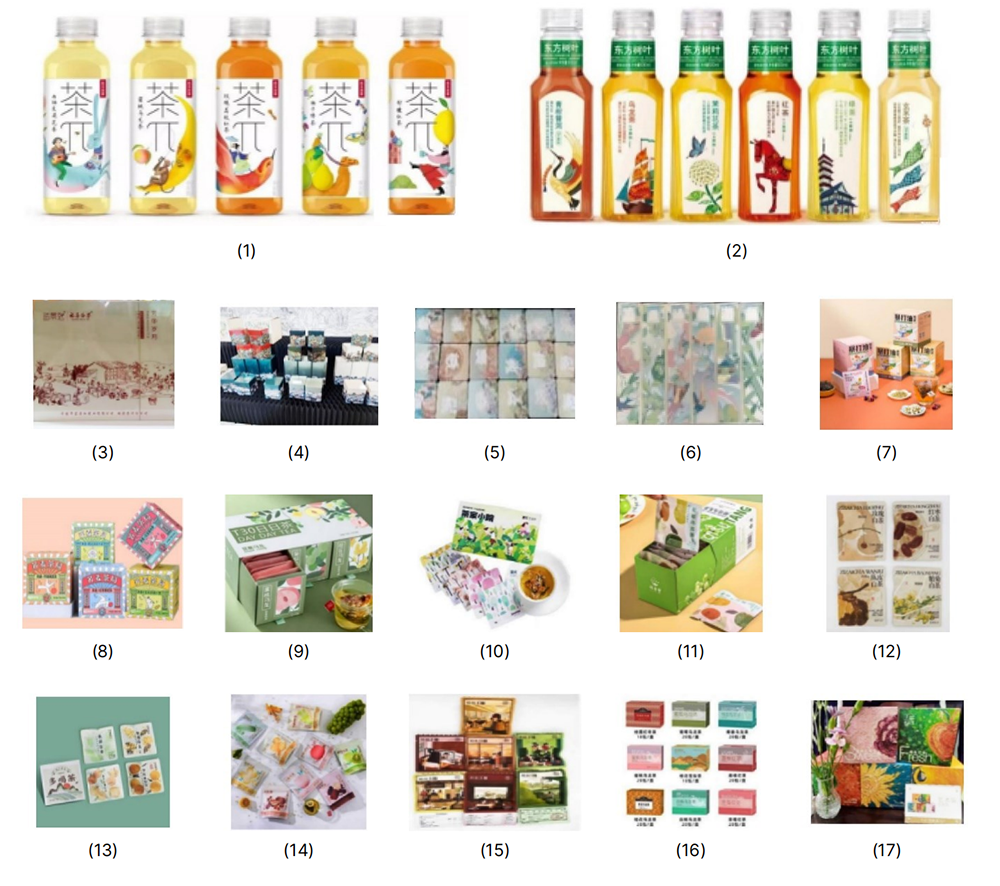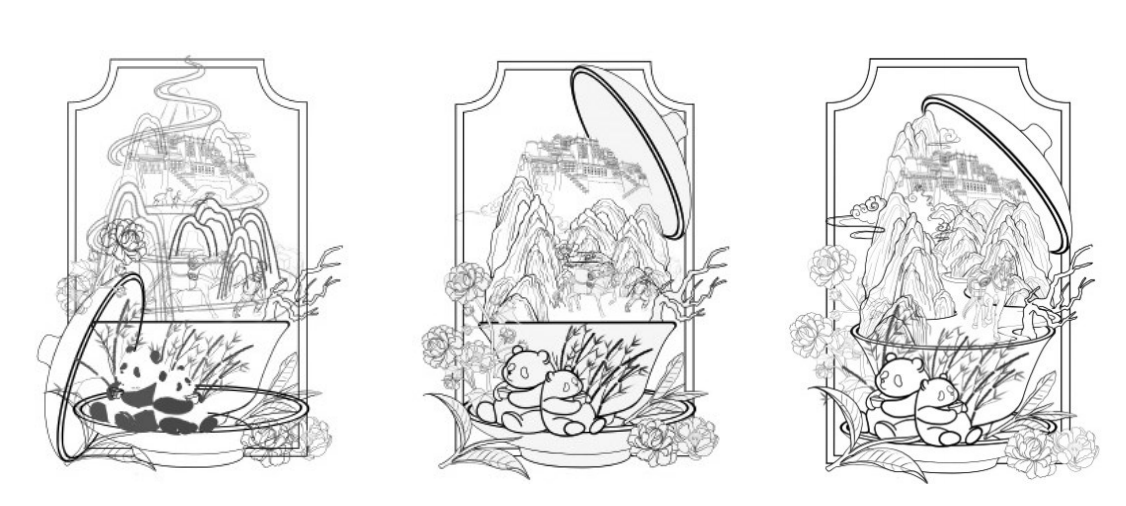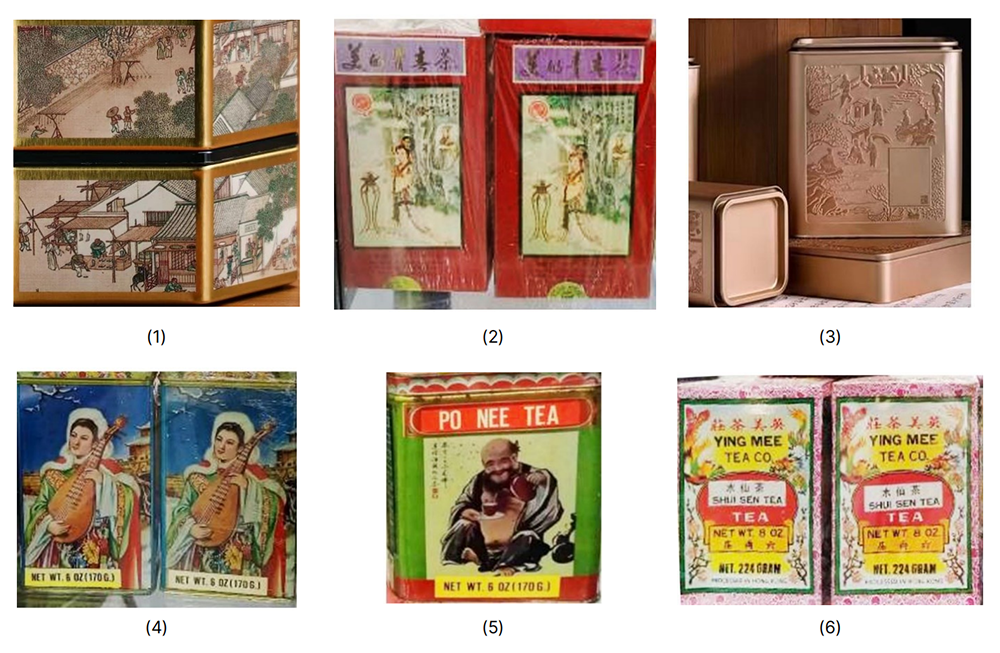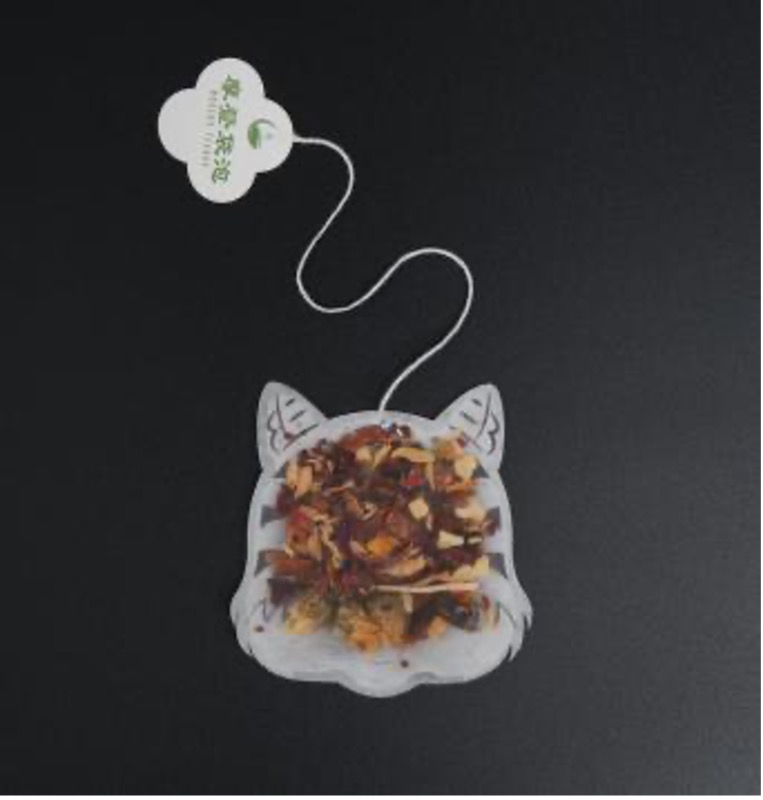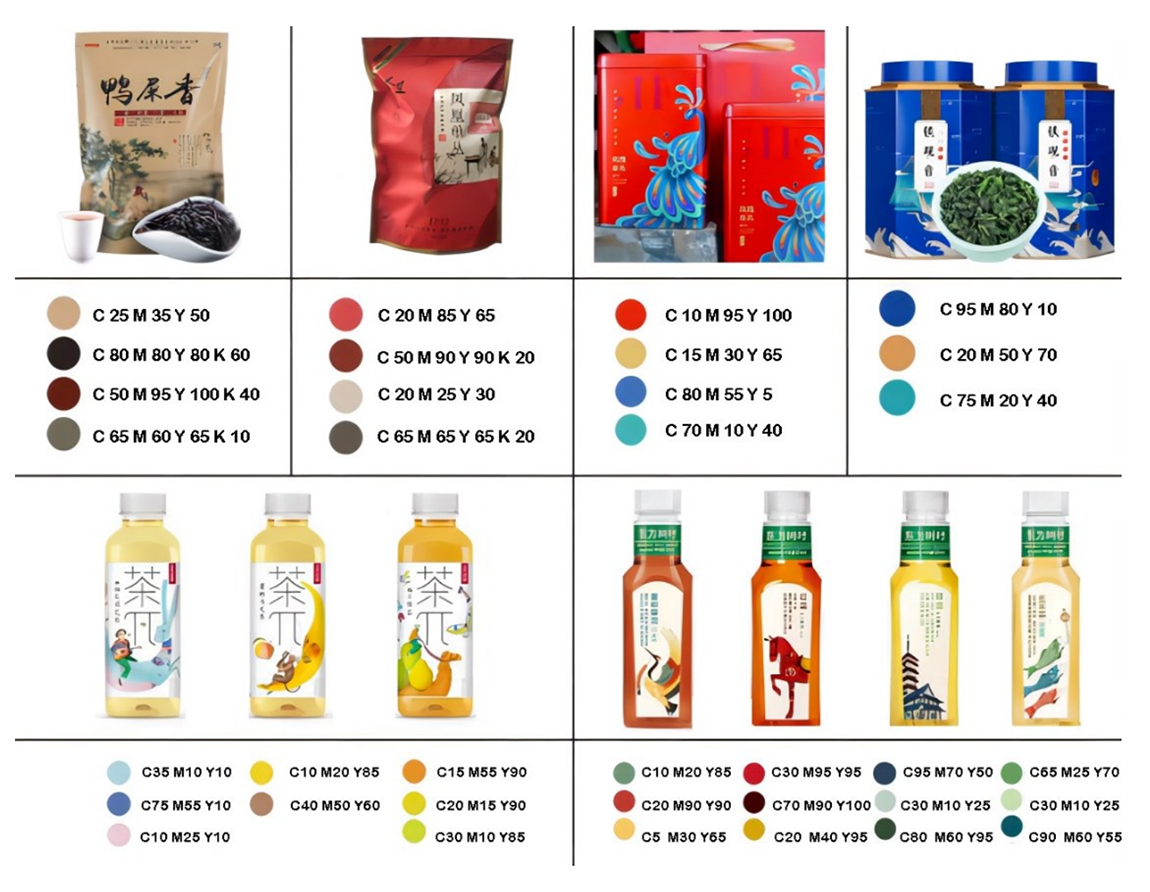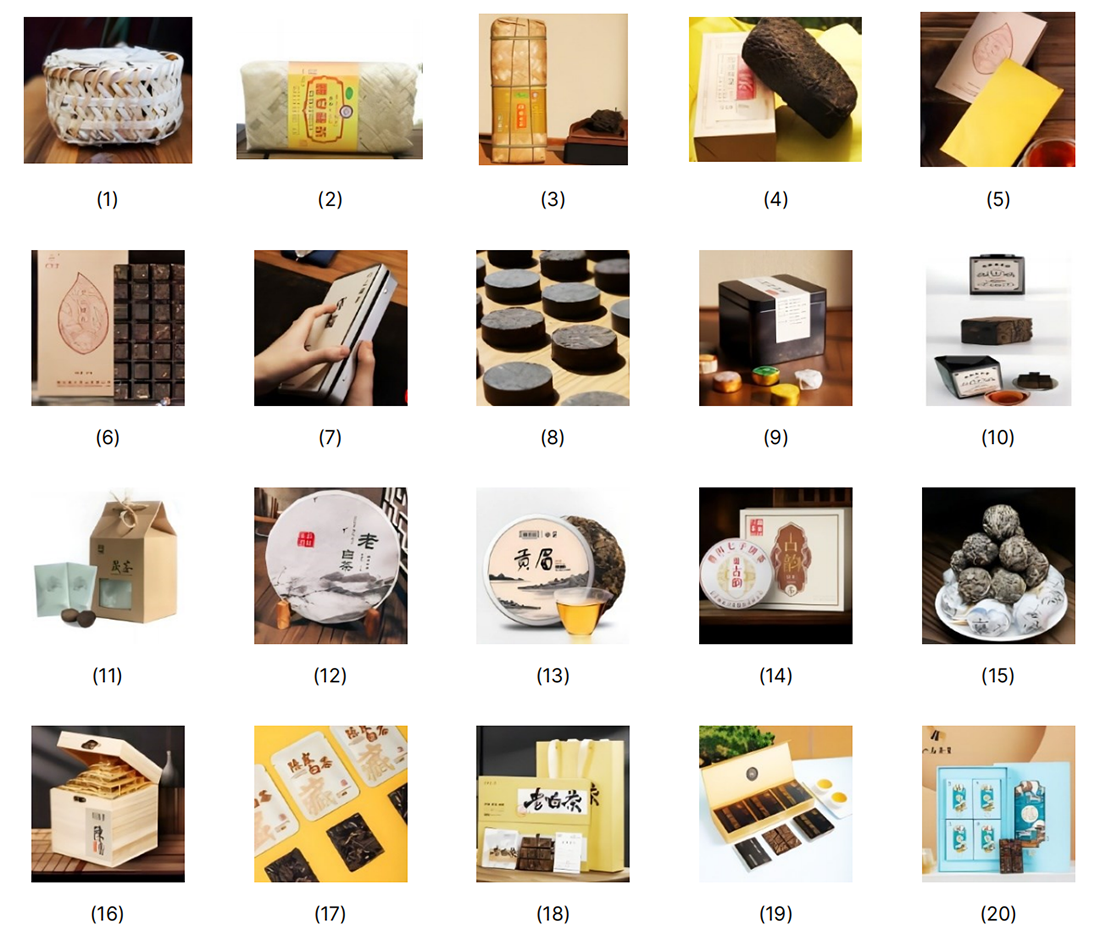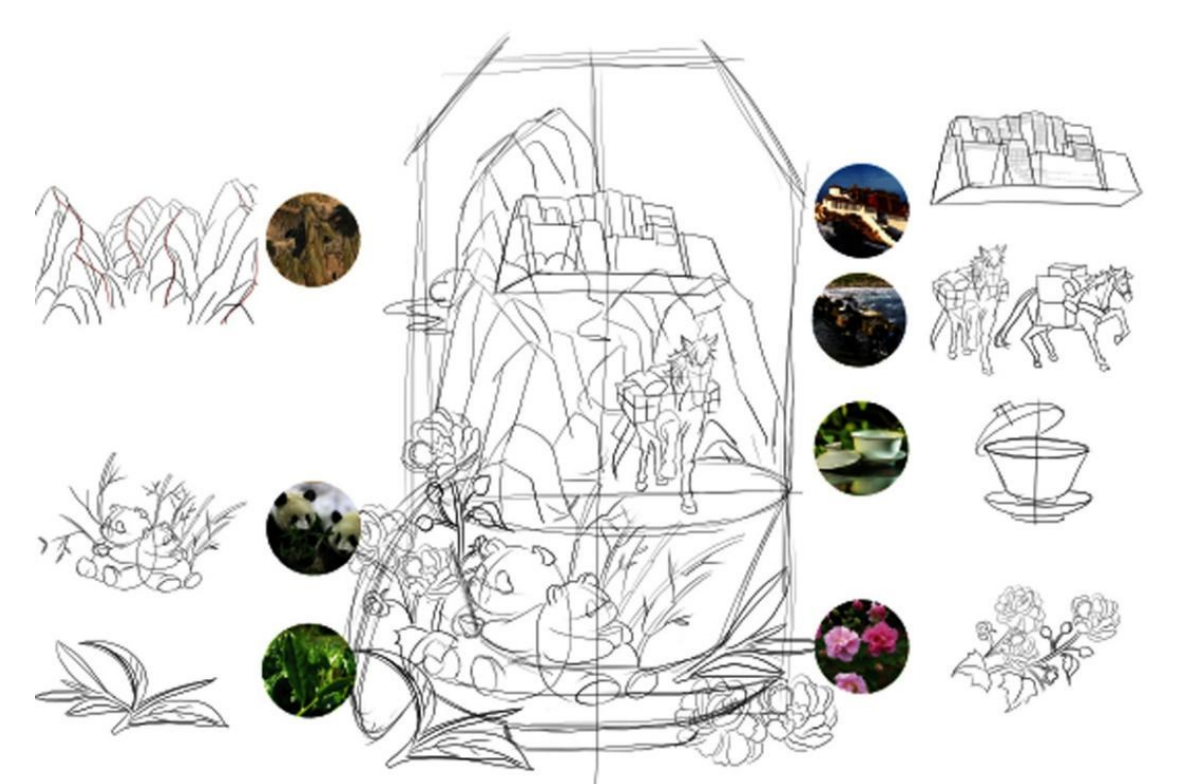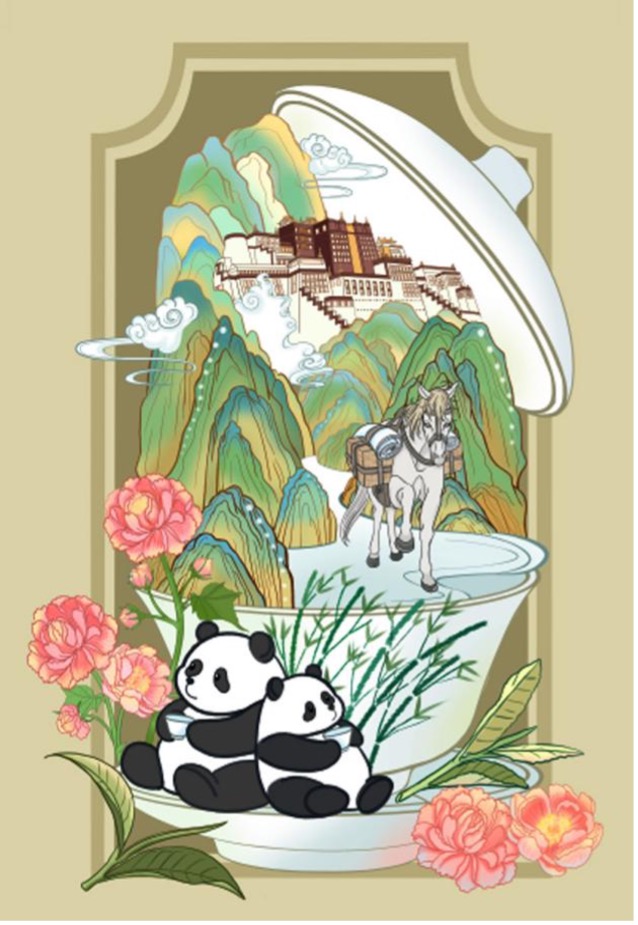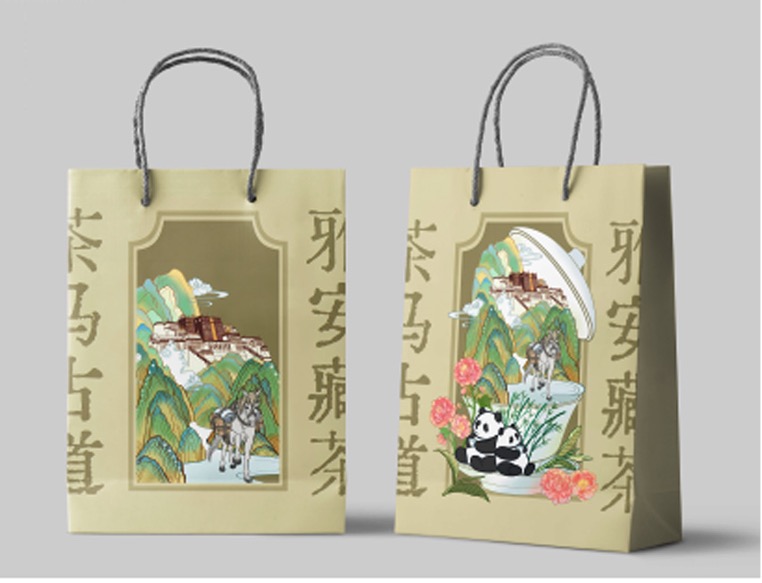© 2024 by the authors. Published by Michelangelo-scholar Publishing Ltd.
This article is published under the Creative Commons Attribution-NonCommercial-NoDerivs 4.0 International (CC BY-NC-ND, version 4.0) license (https://creativecommons.org/licenses/by-nc-nd/4.0/), which permits non-commercial use, distribution, and reproduction in any medium, provided the original work is properly cited and not modified in any way.
Share and Cite
Chicago/Turabian Style
Siqi Lin, and Yu-Lin Hsu, "Application of the Ancient Tea-Horse Road Illustrations in Ya’an Tibetan Tea Packaging." JDSSI 2, no.1 (2024): 16-36.
AMA Style
Siqi Lin, and Yu-Lin Hsu. Application of the Ancient Tea-Horse Road Illustrations in Ya’an Tibetan Tea Packaging. JDSSI. 2024; 2(1): 16-36.
References
1. Peijie Luo, “Research on the application of illustration art in tea packaging design,” China Packaging, no. 8(2022): 33-36.
2. Qianqian Yang, “On the ethical dimension of ethnic minority tea culture on the Ancient Tea-Horse Road,” Journal of Inner Mongolia Normal University (Philosophy and Social Sciences Edition), no. 5(2020): 114-120.
3. Huili Zhang and Zhiqi Zhou, “Research on illustration design methods in tea packaging,” Fujian Tea, no.11(2021): 265-267.
4. Wang W, Illustration Design, (Beijing:People’s Fine Arts Publishing House,2021), 2.
5. Yibing Yun, “Discussion on commercial illustration and brand development,” Western Leather, no. 6(2020): 115.
6. Wang Y, Li X, and Sun S, “On the impact of computer art design on commercial illustration,” Talent, no.3(2011): 229-230.
7. Fu W, “Discussion on modern illustration design,” Art Panorama, no. 3(2012): 131.
8. Li Y, “Discussion on the popularity of commercial illustration,” Science and Technology Association Forum (Second Half of the Month), no. 2(2010): 110-111.
9. Wang Y, “Overview of current tea outer packaging types from the perspective of packaging style,” Fujian Tea, no. 8(2018): 172.
10. Wang J, “Research on narrative illustration design in food packaging,” (M.A. thesis, North China University of Technology, 2020, 68).
11. Liu D and Zhao L, “Expression methods of hand-drawn illustration in food packaging design,” Food and Machinery, no.7(2022): 144-173.
12. Zeegen L. et al., What is Illustration Design? (Beijing: China Youth Publishing House,2015), 92.
13. Yang W and Xu C, “Cognition and Design: Selection of Illustration Style in Native Products Packaging Design Based on Neurocognitive Science,” NeuroQuantology, no. 6(2018): 385-390.
14. Bai X, “Illustration design in tea π packaging,” Western Leather, no. 2(2022): 120-122.
15. Liu L and Feng X, “Research on the Southwest the Ancient Tea-Horse Road in the context of the Belt and Road Initiative: Review, reflection, and prospect,” Journal of Wuhan University (Philosophy and Social Sciences Edition), no. 3(2022): 77-84.
16. Feng C, “History behind the image: The relationship between the early Tang Dynasty and Tubo seen from the ‘Arrival of Princess Wencheng,’” Art Education, no. 4(2015): 94-95.
17. Zhang J, Yang L, Wu J, et al., “Application of tea culture in illustration design course reform,” Art Appreciation, no.29(2019): 345-346.
18. Tan Q, “On the application of commercial illustration in Nongfu Spring design,” Fujian Quality Management, no. 18(2017): 37.
19. Liu X and Yang J, “Research on the design of characteristic cultural and creative products of the Ancient Tea-Horse Road,” Packaging Engineering, no. 18(2022): 425-433.
20. Peng L, “Remanufacturing and application of Tea-Horse culture symbols in the packaging of Anhua black tea,” (M.A. thesis, Guangxi Normal University, 2020, 60).
21. Zhang Y, “Ancient Road Jin Feng - Brand illustration creation and research of ‘Taste of the Road,’” (M.A. thesis, Beijing Institute of Printing, 2021, 35).
22. Wang X, “Research on the packaging design of Anhua black tea based on the culture of the Ancient Tea-Horse Road: Taking ‘Ancient Road Seeking Fragrance’ Anhua black tea brand packaging design as an example,” (M.A. thesis, Hunan University of Technology, 2017, 36).
23. Li R, “the Ancient Tea-Horse Road - The Distant Sound of Cow Bells, the Distant Sound of Horse Bells,” Youth Times (Upper Grades), no. 5(2019): 12-15.
Author Contributions
Siqi Lin conceived the structure of the paper, drew illustrations, and finished the manuscript, and Yu-Lin Hsu modified the paper and the tables.
Conflicts of Interest
The authors have no conflicts of interest with respect to the research, authorship, or publication of the paper.
Funding
Not applicable.
Application of Illustration in Packaging Design
Domestic scholars’ research primarily focuses on the principles, methods, and expressions of illustration packaging design, covering a wide range of topics. Wang Yanna noted that the strategic incorporation of traditional cultural elements can render tea products unique. By leveraging the rich connotations of tea culture, the overall product essence can be displayed. Various varieties and types of tea products can be showcased through pattern design, textual information, and other content [9]. Regarding the principles and methods of illustration packaging design, Wang Jiaqi elaborated on how narrative illustrations convey story ideas, themes, and designers’ creative intentions to consumers. This is achieved through composition elements that organically link design elements in the picture according to composition principles that explain the subject, time, space, and story plot within the narrative [10]. Liu Dalin and Zhao Lina detailed the origins, methods, and differences between computer software and hand-drawn illustrations in illustration packaging design expression. They also discussed techniques for integrating various elements, such as history, modernity, and emotion into illustrations to enhance visual richness [11]. In “What is Illustration Design?” the author extensively discusses the order and structure of narrative illustration, emphasizing the importance of reading and understanding the story to identify plot points with the greatest visual impact [12]. Additionally, from the perspective of human neurocognition, local product packaging design is examined in terms of the illustration style and packaging design art form [13]. Specific cases, such as the study of Bai Xianrong tea π-packaging, examine product packaging design, illustration design, and the integration of illustration design into packaging [14].
However, during the author’s visits and research on these types of illustrated packaging, some issues were identified. Some illustrations were designed purely for aesthetic appeal, lacking cultural significance, and failing to highlight product information. This resulted in consumers being unable to obtain useful product information solely from the packaging illustrations when making purchasing decisions.
From a color analysis perspective (Figure 5), illustrations of traditional tea packaging tend to use single colors with low brightness and high saturation, primarily focusing on red, green, and blue hues. On the other hand, illustrations with rich colors, utilizing gradients within the same color scheme or contrasting colors, and less saturation, are preferred by younger consumers.
Literature Review
Illustration
Meaning and Historical Development of the Illustration
Today, with the rapid development of the domestic economy, merchants have begun to develop strategies to differentiate their products in complex market environments. Consequently, they have gradually recognized the importance of personalizing products and establishing unique brand identities. Among these strategies, sufficient, appropriate, and personalized commercial illustrations are vital in helping brands establish a distinct image and enhance their cultural influence [5]. Wang Yang and others noted that the continuous advancement of domestic information technology has provided more platforms and formats to create commercial illustrations [6]. Fu Weiwei emphasized three principles for modern commercial illustration: conveying consumer demands, aligning with public aesthetic preferences, and enhancing product characteristics [7]. Li You suggested that the public’s perception of commercial illustration often revolves around its role in promoting goods, highlighting three key characteristics: ubiquity, diversity, and digitization. Through research and investigation, it has been concluded that the most popular illustrations are simple, general, cute, and charming and are often presented in a flat style with minimal intricate details [8].
Color coordination and illustration display
We will adopt a color coordination strategy. We will ensure that the selected colors harmonize with the culture of the Ancient Tea-Horse Road and the chosen elements. Soft tones such as pink, white, and warm hues are used to convey the warmth of the hibiscus flower. The contrasting black and white colors highlight the adorable traits of the panda. Golden and red hues will accentuate the solemnity and grandeur of the Potola Palace. Natural green and deep tones will be employed for the tea leaves and horses to emphasize the unique characteristics of the tea and the resilience of the Ancient Tea-Horse Road.
Illustration Display: We will focus on the theme of the Ancient Tea-Horse Road, showcasing various elements such as the hibiscus flower, panda, the Potola Palace, teacup, tea leaves, and horses in the illustrations. Through carefully designed illustration displays, we aim to present the charm and landscape of the Ancient Tea-Horse Road culture. The illustrations will be presented in a vivid and eye-catching manner, allowing viewers to immediately associate with the magnificent scenery and rich culture of the Ancient Tea-Horse Road.
Color and Composition Harmony: We will ensure that the color coordination and composition in the illustrations complement each other, creating a unified and harmonious visual effect. Colors and composition elements complement and enhance one another, making the illustrations more attractive and expressive.
Through these strategies, we aim to design tea packaging illustrations that resonate with the culture of the Ancient Tea-Horse Road and appeal to young audiences, effectively inheriting the culture while capturing the attention of the target audience. The color scheme for the “Tea Mountain Horse Road” follows a series of color extractions and matches of color elements, leading to the final illustrations shown in Figure 9-11.
Application of the Ancient Tea-Horse Road Illustrations in Ya’an Tibetan Tea Packaging
In contemporary emerging tea packaging illustrations, the following are observed: The illustrations on the packaging are more narrative or storytelling-oriented, adding fun and uniqueness to the product beyond its inherent characteristics, such as the “Tea π” illustration series packaging (Figure 4.1). The cultural meanings of the illustrations are richer than those of traditional tea packaging designs. This type of illustration pays more attention to inherited Chinese culture, such as the “Nongfu Spring Eastern Leaves” illustration series, which tells different tea culture stories (Figure 4.2) or depicts the tea-making process through illustrations (Figure 4.3), the twelve zodiac animals, and the twenty-four solar terms (Figure 4.4-4.6). The types of illustrations are more diverse. Compared to traditional ink and wash illustrations, contemporary tea packaging illustrations mainly use CG illustrations or watercolor forms of expression. Illustrations are used in packaging designs and logo designs. They highlight brand characteristics while establishing a unique corporate image. For example, “Tea Colorful World” uses market scenes as illustration content, integrating the brand’s products into the crowd and into daily life (Figure 4.15).
Introduction
Background and Significance of the Research
Background
With advances in digital information technology, the scope and forms of illustration have diversified. In the new era, designers have endowed illustrations with deeper connotations and functions, such as cultural communication and commercial development. Consequently, the use of illustrations is permeating various fields [1]. Due to their decorative nature, using illustrations in tea packaging can attract more young consumers to the tea market. Furthermore, in today’s fast-paced information age, illustrations swiftly convey product information and intuitively communicate brand uniqueness and cultural connotations[2].
The Ancient Tea-Horse Road, historically formed during the Tea-Horse trade between agricultural regions in mainland China and nomadic areas on the frontier, served as a vital route for economic and cultural exchanges and integration. Spanning rugged terrain that connects plateaus and basins, this travel route bears witness to the indomitable spirit of the “Tea Back” and caravans, embodying the Chinese nation’s enduring pursuit of a better life amidst nature’s challenges. As the Tea-Horse trade progressed, the connotations of tea culture enriched daily and spiritual life along the route. Therefore, preserving and perpetuating the spirit of the Ancient Tea-Horse Road holds great significance in safeguarding and inheriting the tea culture heritage of ethnic minorities[3].
Given the complexity of China’s tea market and the proliferation of various beverage options, tea has gradually lost its competitiveness among young consumers and its role as a conveyor of Chinese culture. In the face of fierce industry competition, illustration-style packaging design helps break with product homogenization, enhance enterprise competitiveness, highlight brand personality, and establish brand differentiation[4].
The scenic beauty and humanistic elements of the Ancient Tea-Horse Road possess significant aesthetic value and importance. Integrating the Ancient Tea-Horse Road into packaging designs through illustrations enriches the depth of illustrations and promotes and disseminates the culture of the Ancient Tea-Horse Road. It allows tea products to stand out among numerous packaging designs, effectively propagating tea culture and facilitating the organic integration of the Ancient Tea-Horse Road with economic development.
Research Significance
First, using illustrations in tea packaging design helps tea brands stand out in the chaotic and complex market environment, subtly enhancing brand visibility and realizing commercial value. Second, illustrations facilitate popularizing tea culture among young consumers, catering to their aesthetic preferences, expanding the commodity market, and proactively promoting tea culture. Third, illustrations explore innovative models of traditional cultural elements from the Ancient Tea-Horse Road region and provide innovative ideas for tea packaging. Finally, illustrations contribute to the legacy and innovation of the Ancient Tea-Horse Road culture, driving the development of local cultural industries.
The Ancient Tea-Horse Road
Research on Ancient Tea - Horse Road Culture
The research by Feng Xinyue at Liu Auditorium noted that the Ancient Tea-Horse Road during the Sui and Tang Dynasties served as a crucial conduit for Tang and Tibetan trade. By utilizing the tea trade system, the Tang Dynasty gradually integrated this route into the mainland’s economic and trade network. This integration fostered economic development in the southwest region and facilitated cultural exchange and recognition of Central Plains culture by frontier societies [15]. In discussions of Tang and Tibetan trade, a significant historical event was Princess Wencheng’s journey to Tibet. Among the various depictions of this event, the renowned Tang Dynasty painting “Bujitu” stands out. It portrays Emperor Li Shimin of the Tang Dynasty receiving Lu Dongzan, an envoy bringing a marriage proposal from Tubo’s ruler Zambosongzangambu, thus illustrating an important diplomatic encounter between the two countries [16]. Zhang Jing and others emphasized the importance of incorporating traditional tea culture elements into illustration design. Beyond simply exploring historical themes, the integration of spiritual culture and local customs enriches the cultural significance of illustration design. This handed-down culture embodies the simple ideological values and aesthetic preferences of the working people, representing the essence of the spiritual culture of Wanli Tea Ceremony [17].
Research and Application of the Ancient Tea-Horse Road in Design
The image of the “Oriental Leaf” on the black tea packaging by Nongfu Spring, featuring a horse as the design graphic, subtly conveys the historical narrative of tea being introduced overseas with Princess Wencheng in the 15th year of Zhenguan and subsequently traversing the Ancient Tea-Horse Road [18]. Liu Xingquan and Yang Junkun incorporated elements of the Ancient Tea-Horse Road into the production of cultural and creative products related to tourist routes. Their endeavors promoted ancient road culture and explored its commercial value [19]. Penny Peng applied relevant cultural symbols from the Ancient Tea-Horse Road to the packaging of Anhua black tea. This approach highlights the allure of tea culture and the caravan traditions along the ancient route [20].
In her work “Taste of All the Way,” Zhang Yuwei seamlessly blends the charm of the Ancient Tea-Horse Road with the cultural background of Zhangku Avenue. By refining anecdotes and famous legends from the ancient commercial route, Zhang explored better ways to present illustrations in books while emphasizing the cultural charm and development potential of the ancient trade route [21]. On a different note, Wang Xingchen designed the brand packaging of Anhua black tea, using the Ancient Tea-Horse Road culture as a backdrop. By analyzing the product’s packaging modeling, materials, and decoration design, Wang targeted thousands of cakes and fu bricks, aiming to capture the cultural background and design orientation of the product [22]. Finally, Li Ruqing designed a picture book, “Cow Rings in the Far Mountains, Bells in the Far Mountains,” based on the Ancient Tea-Horse Road. This picture book describes the tales of plateau-dwelling teenagers and caravan girls from the valley embarking on their journeys and eventually crossing paths in the city of sunshine [23].
Abstract
This study explores the modernization of tea packaging, departing from traditional landscape-themed illustrations to resonate with younger consumers. With a focus on the Ancient Tea-Horse Road theme and Ya’an Tibetan tea, various methodologies are employed: Literature Review: Illustration styles are analyzed across historical periods to inform modern design choices. Case Analysis: Existing tea packaging designs, particularly those targeting young consumers, and integrating elements of the Ancient Tea-Horse Road, are examined. Field Research: The historical and cultural significance of the Ancient Tea-Horse Road are investigated. Design Implementation: Computer software blended hand-drawn images with modern images. By infusing the essence of the Ancient Tea-Horse Road into Ya’an Tibetan tea packaging through modern illustrations, this study aims to create a visually appealing product that bridges tradition with contemporary aesthetics. This approach revitalizes traditional themes, enhancing product distinctiveness and market competitiveness.
From the perspective of the illustration style of packaging, almost all tea product packaging illustrations primarily adopt a flat style. In this regard, there is little difference between traditional and bagged teas, such as flower teas. Regarding the content of packaging illustrations, illustrations of modern traditional tea packaging often feature aspects of ancient Chinese beauty (Figure 2.2), historical legendary stories (Figure 2.4), or ethnic totems (Figure 2.6). Modern China is a crucial period of social transformation, and tea, as an important export commodity, not only promotes the product but also propagates the traditional national culture through its packaging illustrations.
In traditional forms of modern tea packaging, illustrations typically focus on several themes: The forms of tea leaves, tea mountains, and tea cups were depicted as the starting points for the illustrations (Figure 3.1-3.3). The characteristics of raw tea materials and their place of origin are highlighted. For instance, packaging for Phoenix Dancong often features phoenix motifs as decorative elements (Figure 3.4), while West Lake Longjing tea packaging incorporates dragon designs (Figure 3.5). The artistic conception of tea itself is often represented by ink-style illustrations (Figure 3.6-3.10). Using decorative elements, such as cranes, persimmons, plum blossoms, orchids, bamboos, and chrysanthemums, each package carries an auspicious meaning, as opposed to being arranged in meaningless stacks (Figure 3.11-3.15). Illustrations lacking cultural meaning could also apply to other products. However, without cultural significance, packaging tends to be homogenous, failing to establish the unique identity of tea producers and lacking competitiveness in the market.
Table of Contents
- Abstract
- Introduction
- Literature Review
- Design Investigation and Analysis
- Design Practice
- Conclusions
- Author Contributions
- Conflicts of Interest
- Funding
- References
1 School of Anxi Tea Science, Fujian Agriculture and Forestry University, Fujian, China
2 School of Digital Economics, Fujian Agriculture and Forestry University, Fujian, China
* Author to whom correspondence should be addressed.
JDSSI. 2024, 2(1), 16-36; https://doi.org/10.59528/ms.jdssi2024.0330a15
Received: December 8, 2023 | Accepted: February 5, 2024 | Published: March 30, 2024
In summary, illustrations of traditional tea packaging have struggled to meet the aesthetic demands of modern young consumers. On the other hand, illustrations of tea product packaging have gained favor among young consumers due to designers delving into the cultural stories behind tea, as well as companies striving for distinctive brand characteristics to break away from homogenized packaging. Furthermore, advances in digital information technology and the increasing pursuit of beauty due to improved living standards have also contributed to the popularity of these illustrations among young consumers.
Therefore, to meet the increasing aesthetic needs of young consumers, tea packaging illustrations must not only preserve the practical value of the product but must also showcase the tea culture heritage and imbue the illustrations with new contemporary meanings. This was the main purpose of the investigation and analysis in this study.
Investigation and Analysis of the Ancient Tea-Horse Road
The Ancient Tea-Horse Road, also known as the Ancient Tea-Horse Road, refers to a trade route in southwestern China dating back to the Tang Dynasty. This route facilitated the trade of tea and horses, with caravans of horses serving as the primary means of transportation. With a total length of more than 4,000 kilometers and a history of more than 1,300 years, the Ancient Tea-Horse Road served as an indispensable bridge and link between ancient Tibet and the mainland, holding profound historical and cultural significance.
Tea-Horse trading during the Tang Dynasty began during the reign of Emperor Suzong, initially as a reciprocal gift to minority ethnic groups. By the reign of Emperor Dezong during the Tang Dynasty, commercial Tea-Horse trading had officially commenced. The northern border markets for Tea-Horse trading during the Northern Song Dynasty included areas such as present-day Shanxi, Shaanxi, Gansu, and Sichuan. By the time of the Southern Song Dynasty, they traded Sichuan tea for horses, pooling resources to counterbalance minority ethnic regimes in the northwest. Under these circumstances, the “Tea-Horse Exchange” not only provided the imperial court with significant tea profits but also met the state’s demand for war horses, safeguarding the southwestern border of the Song Dynasty.
During the Yuan Dynasty, rulers originating from the Mongolian steppes terminated Tea-Horse trading. During the Ming Dynasty, Zhu Yuanzhang implemented the policy of “using tea to control the barbarians.” Tea-Horse trading was highly valued, and during the early years of the Hongwu period, Tea-Horse trading was restored. In the thirteenth year of Emperor Yongzheng’s reign in the Qing Dynasty, the state-owned Tea-Horse trading system was again terminated, marking the end of the thousand-year-old Tea-Horse trading tradition in Chinese history.
In summary, the Ancient Tea-Horse Road is a historical product of China’s long-standing Tea-Horse trading practices, promoting economic and cultural exchanges among different regions and ethnic groups in China.
“Ya’an Tibetan Tea” refers to Tibetan tea produced in Ya’an. Tibetan tea, named for its popularity in Tibetan areas since the Tang and Song Dynasties, has been known by various names in different historical periods, including horse tea, border tea, big tea, and Ya tea. For storage and transportation convenience, tea used in Tea-Horse trading is usually processed into compressed tea using certain techniques. Since green tea emphasizes freshness and tenderness and is not suitable for making compressed tea, the tea traded in the Tea-Horse market mostly consists of black tea and dark tea.
It is rare to find Ya’an Tibetan tea packaging with illustrations in the market, but similar types of compressed tea can be analyzed through case studies. Generally, traditional compressed tea packaging materials consist of thin paper for inner packaging and bamboo baskets, bamboo leaves, or hemp ropes for outer packaging (Figure 6.1). With advancements in packaging technology, most compressed teas on the market today are typically packaged as whole blocks using materials such as cowhide paper, nonglossy yellow paper, rough edge paper, white glossy paper, or tinplate iron boxes, according to industry standards, for better moisture resistance and storage (Figure 6.2). Additionally, some compressed teas are processed into smaller pieces after compression and then individually packaged using paper bags or plastic bags or directly placed into paper or wooden boxes for outer packaging (Figure 6.8-6.11). Compressed teas can be processed into various shapes through different techniques, commonly referred to as tea bricks or tea cakes (Figure 6.12). However, with the popularity of individual packaging, they are also processed into smaller shapes, such as round cakes (Figure 6.8), square blocks (Figure 6.10), ball shapes (Figure 6.15), or flakes (Figure 6.17), to reduce volume.
Design Practice
Images are initially recognized through vision and then cognitively processed, leading to associations, memory, and, eventually, impressions. In terms of significance, impressions emphasize the “identification of mood and feelings, but lacks a certain level of systematization and organization” (Chen Xiaoming, 1992, p69~70). Visual impressions include posture, appearance, features, color, etc. If visual elements such as form, posture, and features have visual appeal and resonate with the soul and are accompanied by color, sound stimuli, or repeated impressions, they are easily established in the mind. In summary, images are conveyed through design methods utilizing visual language (the language of visual communication) or visual codes to visually and systematically express relevant information.
Humans use “graphics” to convey messages of communication. Ancient Chinese texts once said, “There are three meanings of drawing: one is the drawing of principles, which refers to hexagrams; the second is the drawing of recognition, which refers to characters; the third is the drawing of forms, which refers to paintings.” This shows that even graphics can be classified into different forms. The visual psychologist Arnheim explains them in three forms:
- Representational visual symbols, which are direct and concise representations of an object or action according to its form, visualized through drawing;
- Abstract visual symbols, which simplify the essential elements of a message into graphical forms to express causality, idealization, or indication;
- Arbitrary visual symbols, which are unrelated to the concrete form or abstract concept of actual objects. It is original, systematic, conventional, and must be recognized.
In terms of visual communication, representational visual symbols focus on the contours and appearances of shapes, constructing the symbol subject through common object characteristics. Abstract visual symbols involve abstracting and simplifying concrete forms and transforming concepts, symbols, and meanings into visual representations. Constructing arbitrary visual symbols emphasizes originality in expression, and conveying symbols requires continuous advocacy, education, and information dissemination to achieve meaning transfer and connection. The boundaries between these three are not clearly distinguishable but rather exist simultaneously in comprehensive performance.
Design Theme
After investigating, analyzing, and comparing a large number of tea leaf illustration packages, this design aims to promote the culture of the Ancient Tea-Horse Road, enrich illustration packaging, and create a tea leaf illustration package that appeals to young people. Materials from the Ancient Tea-Horse Road along the Sichuan‒Tibet route was selected for illustration, with Ya’an Tibetan tea as the design target. The Ancient Tea-Horse Road is divided into two parts: cultural and material. Relevant representative patterns were identified, such as those listed in Table 3 to conceptualize the cultural dimension, and in Table 4 to conceptualize the material dimension.
Key Content and Research
Starting from the developmental trajectory of illustration, the paper explores innovative tea packaging cases in the market, analyzes the characteristics of illustrations favored by young consumers, and reviews the literature related to the Ancient Tea-Horse Road. The main aspects of the research study are as follows:
- It analyzes the characteristics of illustration styles in different periods in China. Using a timeline from ancient China to modern times, we review the historical development of illustration and analyze its current status, environmental influence, main carriers, and functional roles.
- It searches for information to analyze historically the characteristics of illustration packaging cases favored by young consumers in the market, summarizing and discussing their elements, lines, colors, and compositions.
- It extracts elements related to the Ancient Tea-Horse Road to enrich product packaging by collecting literature related to the Ancient Tea-Horse Road, its developmental history in terms of time and space, historical stories, spiritual connotations, and cultural heritage.
- It illustrates packaging design practices with elements of the Ancient Tea-Horse Road. Combining the research foundation of illustration, the characteristics summarized in the previous section, the extraction of elements from the Ancient Tea-Horse Road, and the target audience’s needs for design services, tea packaging was designed with an illustration style.
The subject of the research is Ya’an Tibetan Tea, which targets young consumers by using illustrations of the Ancient Tea-Horse Road as the design content and designing a tea package with an illustration style. The key objectives of this research are as follows:
- Search for information to understand the developmental history of illustration and summarize its characteristics in different eras.
- Review cases to analyze the main characteristics of tea-drinking illustrations that target young consumers in the market.Fully explore elements related to the Ancient Tea-Horse Road by conducting morphological analysis, extraction, summarization, and generalization.
- Fully explore elements related to the Ancient Tea-Horse Road by conducting morphological analysis, extraction, summarization, and generalization.
Research Methods and Process
This research employs the following methodologies:
- Literature Review Method: By searching for relevant literature on the development history of illustrations, illustration packaging cases, the Ancient Tea-Horse Road, and the application of elements, I aim to understand the historical development of illustrations, explore various illustration styles, and summarize the theoretical foundations and content references for the paper.
- Case Study Method: By analyzing historical and current tea illustration packaging designs that are popular among young people, I aim to provide the basis for the composition, color, lines, and typography of the design work.
- Field Research Method: By conducting field research on certain sections of the Sichuan‒Tibet route of the Ancient Tea-Horse Road, I aim to determine the cultural atmosphere of the Ancient Tea-Horse Road, observe local customs, and deepen my understanding of its meaning.
The specific research process is as follows:
- Literature compilation: Based on the research direction, the relevant literature on illustrations, packaging, the Ancient Tea-Horse Road, etc., was searched using keywords. After reviewing the domestic and foreign literature, the literature is organized, analyzed, and summarized to determine the research title, background, significance, and methodology.
- Problem identification: Considering issues such as the predominance of traditional styles in Chinese tea packaging, the lack of creativity, excessive design repetition, lack of cultural meaning, and the limited young consumer base, a tea illustration packaging that suits young consumers and actively promotes tea culture is proposed.
- Problem Analysis: Many illustrations selected for traditional Chinese tea packaging lack cultural meaning and creativity and fail to meet the aesthetic demands of most young people. Additionally, the Chinese tea market lacks a significant young consumer base, resulting in limited familiarity with tea culture among young people. Moreover, existing tea illustration packaging in the market is excessively homogenous, leading to inadequate brand competitiveness.
- Problem Resolution: First, through a literature search, the historical development of illustrations is understood, and the characteristics of illustrations in different periods are analyzed to draw creative inspiration. Second, the case study method is used to extensively explore innovative illustration packaging designs in the market, especially those targeting young consumers, summarizing their characteristics and focusing on identifying the Ancient Tea-Horse Road expression. Solutions are sought for possible problems in tea packaging design. Third, through field research, the historical stories, local customs, and cultural significance of the Ancient Tea-Horse Road are explored in-depth. Finally, utilizing computer software, designs are created and adjusted based on hand-drawn illustrations.
Yu-Lin Hsu 2 *
Siqi Lin 1,
by
Depending on the theme and style of the illustration, these composition techniques can be used individually or in combination to achieve the best visual representation.
Through browsing illustration cases and searching for relevant information, we summarized eight common illustration styles classified by visual style for illustration works (Table 2):
These are common illustration styles, each with unique characteristics and charm. Artists can choose the style that best suits their creations’ themes and personal preferences.
Investigation and Analysis of the Effects of Illustrations on Tea Packaging
In this survey and study, the author collected and analyzed a variety of tea products, including traditional teas, flower teas, flavored teas, and tea beverages, by browsing numerous tea illustration packaging examples on the market, visiting tea packaging design exhibitions, and exploring major online sales platforms.
From a packaging perspective, traditional tea packaging mainly consists of paper - plastic composite materials for bag packaging, metal tin packaging, or wrapping with oil paper or white cotton paper. However, emerging tea beverages such as bagged and flower teas predominantly use paper boxes, often with individually wrapped packets inside. These tea bags do not have a traditional triangular shape but are more creative, making them unique to tea packaging (Figure 1). This design innovation allows the eye to conform to the sea of tea packaging.
Design Investigation and Analysis
Survey and Analysis of Illustrations
Through browsing illustration cases and searching for relevant information, we summarized eight common composition techniques for illustrations (Table 1):
In-depth Design
Design of the sketch and line drawing
Based on the design theme, further elements were selected for illustration design. Finally, the Hibiscus flower (the city flower of Chengdu) and the panda were selected to represent Sichuan, the Potola Palace was selected to represent Tibet, and elements such as the lid-bowl, tea leaves, horses, mountains, etc., were selected to represent the Ancient Tea-Horse Road. The illustration aims to depict how the Ancient Tea-Horse Road was transformed from the lingering fragrance of tea, with all the scenery placed between the lid and the bowls, representing the cultural integration of different ethnic groups in Sichuan and Tibet through the Ancient Tea-Horse Road, condensed and merged into a cup of tea. The results of the extraction of expressive elements, rough sketches, compositions, and final drafts are shown in Figure 7-8.
Design Outcome Showcase
The final illustrations and packaging designs for the Ancient Tea-Horse Road are prominently displayed. Each design element, from the cultural symbols to the material representations, is showcased meticulously. The canned packaging design is exhibited, highlighting its robustness and moisture resistance compared to traditional paper packaging. Visitors can observe how black tea is compactly stored in cans for convenience and reduced waste. The color schemes extracted from both cultural and material aspects are displayed, demonstrating the thoughtful consideration of color elements in the design process. Each color choice reflects the rich cultural heritage and practical requirements of the packaging.
Visitors can also explore the journey of the Ancient Tea-Horse Road through illustrations, from the extraction of cultural elements to the finalization of the design. The exhibition provides insights into the design process and the significance of each chosen element. Overall, the Design Outcome Showcase offers a comprehensive view of the creative process behind the Ancient Tea-Horse Road packaging design, emphasizing its cultural significance, practicality, and aesthetic appeal. The packaging for the Ancient Tea-Horse Road is shown in Figure 12, while the paper bag packaging is depicted in Figure 13.
Conclusions
Research Conclusion
The paper employs case analysis and field research to examine the presentation forms of illustrations in traditional tea packaging and emerging tea product packaging. It also delves into historical and cultural information related to the Ancient Tea-Horse Road, along with the characteristics of associated tea packaging. With the Ancient Tea-Horse Road as the thematic focus, the objective is to design illustration packaging for Ya’an Tibetan tea, addressing the aesthetic preferences of young consumers for traditional tea illustration packaging while promoting the Ancient Tea-Horse Road culture in the southwestern region.
The heroic tales of individuals navigating the challenges of the Ancient Tea-Horse Road persist in the collective memory of the southwestern region’s inhabitants. Some of these stories are immortalized in picture books or adapted into stage plays, showcasing the enduring vitality and inclusiveness of the Ancient Tea-Horse Road culture. Despite the decline of its economic function with the development of infrastructure, trade continues along the route, albeit with diminished historical significance. However, the market for traditional teas lacks a youthful consumer base, leading to a lack of appreciation for the historical and spiritual significance embodied by the ancient road.
Through extensive research and analysis of tea packaging illustrations, this design initiative uses the Ancient Tea-Horse Road as inspiration, incorporating representative elements from the “The Ancient Tea-Horse Road Sichuan‒Tibet Line” into the design of Ya’an Tibetan tea packaging. The objective is to imbue the illustration with enriched meanings, promote the culture of the Ancient Tea-Horse Road, and create tea packaging that resonates with young consumers.
Recommendations and prospects
In the complex and competitive tea market, it is crucial to explore potential consumer groups. Illustrations, a favored form of art among young people, can be integrated into tea packaging design to satisfy their aesthetic preferences for traditional tea packaging. Moreover, in an era of information overload, illustrations serve as efficient conveyors of information, necessitating a balance between content and product information.
However, illustrated packaging styles are prevalent in the tea market, necessitating a unique cultural significance to stand out. China possesses abundant traditional cultures that await further exploration. The paper proposes tea packaging themed around the Ancient Tea-Horse Road, infusing illustrations with cultural significance, promoting the Ancient Tea-Horse Road related brands, and contributing to the dissemination and promotion of the Ancient Tea-Horse Road culture.
As the economic status of modern society advances, consumers shift their focus from “material beauty” to “spiritual beauty,” heightening aesthetic awareness and presenting challenges and opportunities for packaging design. While embracing advanced design concepts, designers should prioritize people-oriented design, integrate exceptional traditional cultures, and showcase national characteristics, elevating Chinese design to the global stage.
